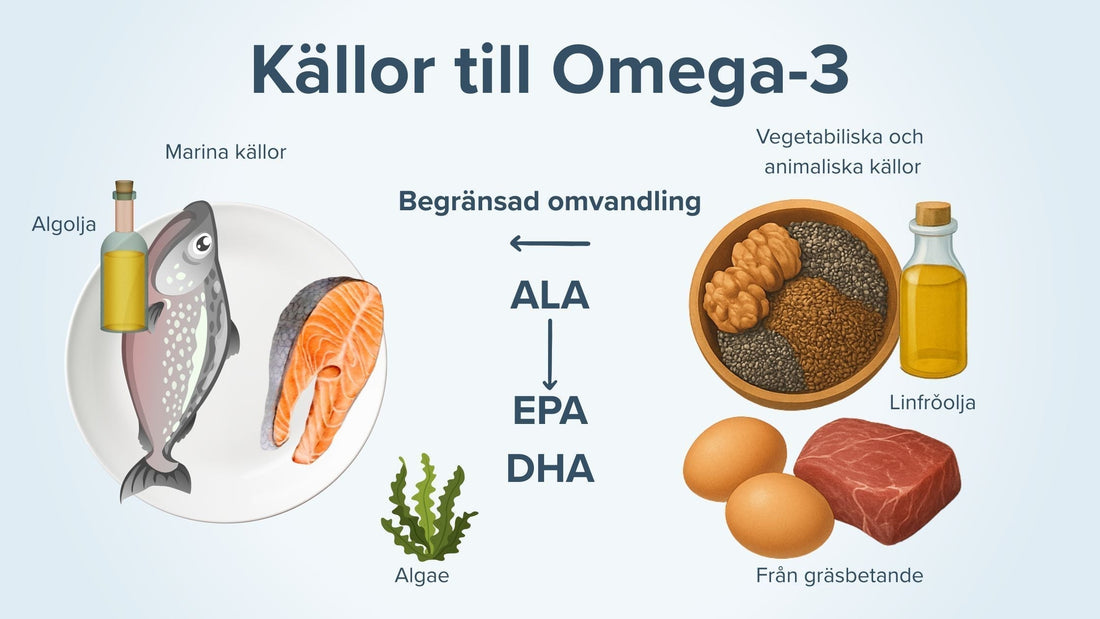
Sources of OMEGA-3
Share
Omega-3 – Important sources and what you need to know
At ArcticMed, we know that omega-3 is crucial for our health, but did you know that not all omega-3 fatty acids are equally effective for the body? Here we explain which sources are best.
Omega-3 – What is the difference between ALA, EPA, DPA and DHA?
Omega-3 consists primarily of four fatty acids:
-
ALA (alpha-linolenic acid) – plant-based
-
EPA (eicosapentaenoic acid) – marine
-
DHA (docosahexaenoic acid) – marine
-
DPA (docosapentanoic acid) – marine and often overlooked, but important
ALA is found in vegetable oils such as flaxseed oil, walnuts, chia seeds and hemp seeds. EPA, DHA and DPA are mainly found in fatty fish and certain types of algae.
What makes DPA unique?
DPA is an intermediate chain between EPA and DHA and occurs naturally in small amounts in fish and in even higher concentrations in certain marine oils and breast milk. DPA has been shown to have several health benefits:
-
Effective anti-inflammatory effect
-
Support for cardiovascular health
-
Improved absorption and conversion to other omega-3 fatty acids
Recent research suggests that DPA acts as a flexible "buffer" in the body – it can be converted into both EPA and DHA when needed, making it extra valuable.
Where does omega-3 originally come from?
All omega-3 fatty acids originate in the plant kingdom – mainly in algae and grasses. Plants produce ALA, which is then converted in animals to EPA, DPA and DHA. This is why meat and eggs from grass-fed animals contain significantly more omega-3 than animals fed grain.
Omega-3 from fish, algae and grass-fed animals
Fatty fish such as salmon, mackerel and sardines are rich in EPA, DPA and DHA. However, fish do not produce these fatty acids themselves – they get them from plankton and algae. Therefore, algae is the original source of DPA as well.
Our new product, ArcticMed Algal Oil , contains both EPA, DHA and DPA from sustainable microalgae – completely vegan and specially formulated for optimal absorption.
Are vegetable sources enough?
Plant-based omega-3 sources such as flaxseeds and chia seeds only contain ALA. The body converts ALA into EPA, DPA and DHA – but in very limited amounts (often less than 5%). Therefore, plant-based sources are rarely sufficient as the sole source of omega-3.
To get enough EPA, DPA and DHA, we recommend high-quality supplements – such as ArcticMed Omega-3 from fish or algae.
Grass-grazing animals – a natural source of DPA
Studies show that meat and eggs from grass-fed animals not only contain more EPA and DHA, but also higher levels of DPA compared to conventionally raised animals.
Conclusion: The full spectrum of omega-3 is needed
For optimal health, you need more than just ALA. EPA, DHA, and DPA are essential for supporting heart, brain, and inflammation balance. A varied diet with marine omega-3 sources—or a well-thought-out supplement—makes a big difference.
Visit our shop at arcticmed.com and find the right omega-3 for you – with the full spectrum: EPA, DPA and DHA.
References
-
Calder, PC. "Nutritional benefits of omega-3 fatty acids." Food enrichment with omega-3 fatty acids, Woodhead Publishing, 2013.
-
Daley, Cynthia A., et al. "A review of fatty acid profiles and antioxidant content in grass-fed and grain-fed beef." Journal of Nutrition, 2010.
-
Simopoulos, Artemis P. "The Mediterranean diets: The scientific evidence." The Journal of Nutrition, 2001.




